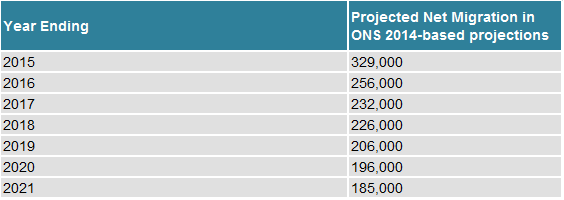The reality of Brexit prompts the question for planning of whether it will impact on the need for housing, and in particular change the housing requirements in emerging Local Plans. An element of the planning effect relates to process issues (e.g. delays in introducing new planning reforms) but we can leave this for another day. This blog focuses on the migration statistics used within the population projections that underpin Local Plan housing figures
[1].
Net international migration to the UK in 2014/15 was
336,000 (636,000 in, 300,000 out). The split between EU/Non-EU is around 50:50 (latest figures show 49:51) so on that basis each component (EU and non-EU) would represent net flow of c.
168,000 p.a.The Office for National Statistics (ONS) 2014-based Population Projections which Government guidance says Local Plans must use to underpin Objective Assessments of Need for housing in Local Plans were released in 2015. They already assume that net in-migration will reduce from current levels to 185,000 p.a. by 2021; a 45% reduction on the 2015 net level. It is assumed to decline as follows:

The 2021 levels are then projected forward as a constant until 2037.
Although a reduction in net migration to the “tens of thousands” was an aspiration of David Cameron, it seems unlikely that net in-migration would fall below the long term figure assumed by ONS with or without Brexit; if anything, the figure of 185,000 p.a. is still likely to under-estimate future levels.
Given the share of net inflows from non-EU countries (168,000 p.a.) is already capable of being controlled by UK Government migration policy (which since 2010 has been seeking to reduce it) it is reasonable to assume no reduction due to Brexit. Therefore, hypothetically, and all things being equal, in order for the ONS Projections long term migration estimate (185,000 net p.a.) to be achieved, net flows from within the EU would have to fall to just 17,000 p.a. (ie reduce by 90%).
All this supports the idea that the ONS projections were, in any event, adopting very cautious estimates of net in-migration for the long term, and thus cautious estimates of population and household growth for planning purposes. Although the ONS did not explicitly take account of Brexit, there is no evidence available to support the notion that leaving the EU will see a reduction in migration of a scale that would be necessary for population estimates to fall below projected levels.
What does this all mean for housing numbers?
The effect of Brexit is impossible to gauge at present because the UK will most likely remain a member of the EU for at least the next two years whilst the terms of exit are negotiated. There is currently no evidence base for arriving at an alternative set of assumptions about future expected migration until the terms of withdrawal are settled, and indeed, it might even be that Brexit simply results in an agreement that links UK access to the Single Market with continuation of the free movement of labour. Equally, were the UK to have a controlled migration relationship with Europe, this might prove just as incapable of reducing EU-migration as it has proved with non-EU flows. Further, if emigration flows out to the EU reduce as part of controls, any changes might simply cancel each other out.
There is simply no way of knowing at this stage, and no coherent basis for Local Planning Authorities, developers or Inspectors to settle upon a different set of migration figures than those currently available from ONS in planning. The next set of ONS projections to be produced (2016-based) will be required to get to grips with the appropriate relevant long term assumptions to adopt.
In summary, the current basis for UK estimates of housing need are already predicated on a 45% drop to total net-in-migration by 2021, so for Brexit to have any downward pressure on planned housing targets in Local Plans, it would need to be assumed that Brexit resulted in European net-migration to the UK falling to virtually zero over the medium to long term. This seems unlikely.
There are other factors driving household growth, including natural change in the population, and age structure (an increasingly elderly population means a greater number of single person households), so migration is only part of the story. Further, many local plans set housing requirements based on factors such as employment growth, the need to improve housing affordability, and the need for affordable housing. All of these can put upward pressure on estimates of housing need drawn solely from population projections.
The data in summary:

*Approximately half of inflows to the UK are from outside of the EU. For the purposes of this analysis we have assumed this is also applicable to the net figure.
Figures may not sum due to rounding.
[1] Housing requirements in Local Plans are based on Objectively Assessed Need which is calculated using demographically-based projections that apply household formation rates to estimates of population change in order to arrive at the number of households in a given local area. Other factors such as employment, market signals and affordable housing need are also considered.





